Effects of Mixed Phase Microphysical Process on Precipitation in a Simulated Convective Cloud
Abstract
:1. Introduction
2. Model Description
Microphysics, Model Domain, Initialization
3. Observation and Simulations
4. Results and Discussion
4.1. Distribution of the LWC
4.2. Distribution of Cloud and Rain Drops
4.3. Distribution of Graupel Particles, Ice Crystals and Snow
4.4. Microphysical Processes of Rain and Graupel
5. Conclusions
Acknowledgments
Author Contributions
Conflicts of Interest
Appendix
| Particles | α | N0 | λ | m(g) | ||
|---|---|---|---|---|---|---|
| Cloud droplets | 5 | |||||
| Raindrops | 2 | |||||
| Ice crystals | 1 | |||||
| Snow | 0 | |||||
| Graupel | 0 |
Appendix 1. Warm cloud Microphysical Parameterization
- The cloud droplets transferred by raindrops through the collection and coalescence process (CLcr)where Erc is the efficiency of collision, and D is the diameter of raindrops. Vr(D) is the terminal fall speed of raindrops.where is the air density, and is the raindrops mixing ratio. The integrated Vr(D) and N(D) (in Table 1) are thenwhere , then the Equation (A3) is given bywhere is air density, and and are the mixing ratio of cloud droplets and raindrops, respectively.
- The cloud droplets transferred by raindrops through the auto conversion process (CNcr), and the auto conversion formula of Kessler is used in the model.
Appendix 2. Cold Cloud Microphysical Parameterization
- Melting and Evaporation processes (MVD)
- 2.
- Condensation process (VD)
- 3.
- The collection and coalescence process (CL)
- (1)
- The collection and coalescence process between raindrops and ice crystalIf the water content of rain meets the condition when , and , then is the source term of graupel particles. Otherwise, and will contribute to the formation of snow particles. Then, is transformed into raindrops when .where the value of is the same as Hong [19], , in which Eir is coagulation efficiency between ice crystal and rain droplets and the value is 0.8. and are the number of ice crystals and raindrops per unit mass of air, respectively, and are specified; and is the representative diameter.
- (2)
- The collection and coalescence process between raindrops and ice crystalwhere , and Eis is coagulation efficiency between ice crystal and snow. when , , and .
- (3)
- The collection and coalescence process between graupel particles and ice crystalwhere , and is the same as . Here, and are the number of ice crystals and graupel particles per unit mass of air, respectively and are specified.
- (4)
- The collection and coalescence process between snow particles and raindropsIf the water content of rain meets the condition when , and , then is transformed into graupel particles. Otherwise, contributes to the formation of snow particles.where . Here, ; and are the number of raindrops and snow particles per unit mass of air, respectively, and are specified; is the representative diameter of particles; and .
- (5)
- The collection and coalescence process between graupel and raindropswhere and .
- (6)
- The collection and coalescence process between graupel and snow particleswhere . Here, when and when .
- (7)
- The collection and coalescence process between cloud droplets and other particleswhere the subscripts of A represent rain (r), ice crystal (i), snow (s) and graupel (g), and the formula are denoted as follows:
- (8)
- When the diameters of cloud droplets and ice crystals meet the conditions: and , respectively, then collection and coalescence process between cloud droplets and ice crystals is denoted by:where the value of see the reference of Hu [25]. Here, , and are transformed into raindrops when .
- 4.
- The Nucleation process (NU)
- 5.
- Melting process (ML)
- 6.
- Atuo conversation process (CN)
- 7.
- Accumulation process (NCL)
Abbreviations
| VDvc(cv) | Water vapor-cloud droplets (auto conversion) |
| VDrv | Raindrops-water vapor (evaporation) |
| CLcr | Cloud droplets-raindrops (collection and coalescence) |
| CNcr | Cloud droplets-rain drops (auto conversion) |
| MVDiv | Ice crystal (melting and evaporation) |
| MVDsv | Snow (melting and evaporation) |
| MVDgv | Graupel (melting and evaporation) |
| VDvi(iv) | Water vapor-ice crystal (condensation) |
| VDvs(sv) | Water vapor- snow (condensation) |
| VDvg(gv) | Water vapor-snow (condensation) |
| NUvi | Water vapor-ice crystal (nucleation) |
| NUrg | Raindrops-graupel (nucleation) |
| NPci | Ice crystal (multiplication) |
| MLic(r) | Ice crystal-cloud droplets/raindrops (melting) |
| MLsr | Snow-raindrops (melting) |
| MLgr | Graupel-raindrops (melting) |
| CLci | Cloud droplets–ice crystal (collection and coalescence) |
| CLcs | Cloud droplets–snow (collection and coalescence) |
| CLcg | Cloud droplets–graupel (collection and coalescence) |
| CLir(ri) | Ice crystal-raindrops (collection and coalescence) |
| CLrs(sr) | Snow-raindrops (collection and coalescence) |
| CLrg | Raindrops-graupel (collection and coalescence) |
| NCLii | Ice crystal-ice crystal (Accumulation) |
| CLis | Graupel-ice crystal (collection and coalescence) |
| CLig | Ice crystal-graupel (collection and coalescence) |
| NCLss | Snow-snow (Accumulation) |
| CLsg | Graupel-snow (collection and coalescence) |
| CNis | Ice crystal-snow (Atuoconversation) |
| CNig | Ice crystal-graupel (Atuoconversation) |
| CNsg | snow-graupel (Atuoconversation) |
| qv | Mixing ratio of water vapor |
| qc | Mixing ratio of cloud |
| qr | Mixing ratio of rain |
| qg | Mixing ratio of graupel |
| qs | Mixing ratio of snow |
| qi | Mixing ratio of ice crystal |
| qh | Mixing ratio of hail |
| Nr | Number of raindrops per unit mass of air |
| Ng | Number of graupel per unit mass of air |
| Ns | Number of snow per unit mass of air |
| Ni | Number of ice crystal per unit mass of air |
| Nh | Number of hail per unit mass of air |
| Fi | The riming ratio of ice crystal |
| FS | The riming ratio of snow |
| T0 | Standard freezing temperature of water |
Air density | |
| LV | Latent heat |
| E | The efficiency of collision |
| D | The diameter of particles |
| V | Terminal fall speed |
saturation |
References
- Zhao, Y.C. Diurnal variation of rainfall associated with tropical depression in south China and its relationship to Land-sea contrast and topography. Atmosphere 2014, 5, 16–44. [Google Scholar] [CrossRef]
- Cui, X.P.; Li, X.F. A cloud-resolving modeling study of short-term surface rainfall processes. Meteorol. Atmos. Phys. 2011, 111, 1–11. [Google Scholar] [CrossRef]
- Tao, W.; Chen, J.; Li, Z.; Wang, C.; Zhang, C. Impact of aerosols on convective clouds and precipitation. Rev. Geophys. 2012, 50, RG2001. [Google Scholar] [CrossRef]
- Liu, J.; Shen, X.Y.; Li, X.F. Radiative effects of water clouds on heat, cloud microphysical and surface rainfall budgets associated with pre-summer Torrential rainfall. Terr. Atmos. Ocean. Sci. 2014, 25, 39–48. [Google Scholar] [CrossRef]
- Liu, Y.; Du, D.G.; Li, Z.L.; Shi, C.X. Analysis and application of the relation between cumulonimbus (Cb) cloud features and precipitation based on FY-2C image. Atmosphere 2014, 5, 211–229. [Google Scholar] [CrossRef]
- Mansell, E.R. On sedimentation and advection in multi-moment bulk microphysics. J. Atmos. Sci. 2010, 67, 3084–3094. [Google Scholar] [CrossRef]
- Zhang, Z.; Zhou, Y. Analyses of composite observations of cloud liquid water and precipitation on the evolution features. Meteorol. Mon. 2010, 36, 83–89. [Google Scholar]
- Solheim, F.; Godwin, J.R.; Westwater, E.R.; Han, Y.; Stephen, J.K.; Marsh, K.; Ware, R. Radiometric profiling of Temperature, water vapor and cloud liquid water using various inversion methods. Radio Sci. 1998, 33, 393–404. [Google Scholar] [CrossRef]
- Kessler, E. On the distribution and continuity of water substance in atmospheric circulation. Meteorol. Monogr. Am. Meteorol. Soc. 1969, 32, 84–85. [Google Scholar] [CrossRef]
- Simpson, J.; Wiggert, V. Models of precipitating cumulus towers. Mon. Weather Rev. 1969, 97, 471–489. [Google Scholar] [CrossRef]
- Wisner, C.; Orville, H.D.; Meyers, C. A numerical model of a hail-bearing cloud. J. Atmos. Sci. 1972, 29, 1160–1181. [Google Scholar] [CrossRef]
- Rutledge, S.A.; Hobbs, P.V. The mesoscale and microscale structure and organization of clouds and precipitation in mid latitude cyclones. XII: A diagnostic modeling study of precipitation development in narrow cold-frontal rainbands. J. Atmos. Sci. 1984, 41, 2949–2972. [Google Scholar] [CrossRef]
- Burning, E.C.; Rust, W.D.; Schuur, T.J.; MacGorman, D.R.; Krehbiel, P.R.; Rison, W. Electrical and polarimetric radar observations of a multicell storm in TELEX. Mon. Wea. Rev. 2007, 135, 2525–2544. [Google Scholar] [CrossRef]
- Liu, C.; Zipser, E.J. The dynamic influence of microphysics in tropical squall lines: A numerical study. Mon. Weather Rev. 1997, 125, 2193–2210. [Google Scholar] [CrossRef]
- Konwar, M.; Maheskumar, R.S.; Kulkarni, J.R.; Freud, E.; Goswami, B.N.; Rosenfeld, D. Aerosol control on depth of warm rain in convective clouds. J. Geophys. Res. 2012, 117, D13204. [Google Scholar] [CrossRef]
- Trier, S.B.; Skamarock, W.C.; Lemone, M.A. Structure and evolution of the 22 February 1993 TOGA COARE squall line: Numerical simulations. J. Atmos. Sci. 1996, 53, 2861–2886. [Google Scholar] [CrossRef]
- Milbrandt, J.A.; Morrison, H. Predicting graupel density in a bulk microphysics scheme. J. Atmos. Sci. 2013, 70, 410–429. [Google Scholar] [CrossRef]
- Mansell, E.R.; Ziegler, C.L. Aerosol effects on simulated storm electrification and precipitation in a two-moment bulk microphysics model. J. Atmos. Sci. 2013, 70, 2032–2049. [Google Scholar] [CrossRef]
- Hong, Y.C. The numerical simulation study of convective stratiform mixed cloud, Part (I)—The model and parameterization of microphysical processes. Acta Meteorol. Sin. 1996, 54, 544–557. [Google Scholar]
- Wang, X.; Xiao, H.; Du, B. Numerical simulation on severe convective rainfall. J. Nanjing Inst. Meteorol. 2002, 25, 656–663. [Google Scholar]
- Xiao, H.; Wang, X.; Zhou, F.; Hong, Y.; Huang, M. A three-dimensional numerical simulation on microphysical processes of Torrential Rain storms. Chin. J. Atmos. Sci. 2004, 28, 385–404. [Google Scholar]
- Guo, F.X.; Zhang, Y.J.; Yan, M.H. Comparison of two parameterization sections for non-inductive mechanism before the first discharge in a simulated single cell storm. Chin. J. Atmos. Sci. 2010, 34, 361–373. (In Chinese) [Google Scholar]
- Klemp, J.B.; Wilhelmson, R.B. Simulations of right- and left-moving storms produce through storm splitting. J. Atmos. Sci. 1978, 35, 1097–1110. [Google Scholar] [CrossRef]
- Hong, Y.C. A 3-D cloud numerical seeding model. Atca Meteorol. Sin. 1998, 56, 641–653. [Google Scholar]
- Hu, Z.J.; He, G.F. Numerical simulation of microprocesses in cumulonimbus clouds (I): Microphysical model. Acta Meteorol. Sin. 1987, 45, 468–484. [Google Scholar]
- Orville, H.D.; Kopp, F.J. Numerical simulation of the life history of a hailstorm. J. Atmos. Sci. 1977, 34, 1596–1618. [Google Scholar] [CrossRef]
- Tripoli, G.J.; Cotton, W.R. Numerical study of an observed orogenic mesoscale convective system. Part Ⅰ: Simulated genesis and comparison with observations. Mon. Wea. Rev. 1989, 117, 273–304. [Google Scholar] [CrossRef]
- Klemp, J.B.; Wilhelmson, R.B. The simulation of three dimensional convective storm dynamics. J. Atmos. Sci. 1978, 35, 1070–1096. [Google Scholar] [CrossRef]
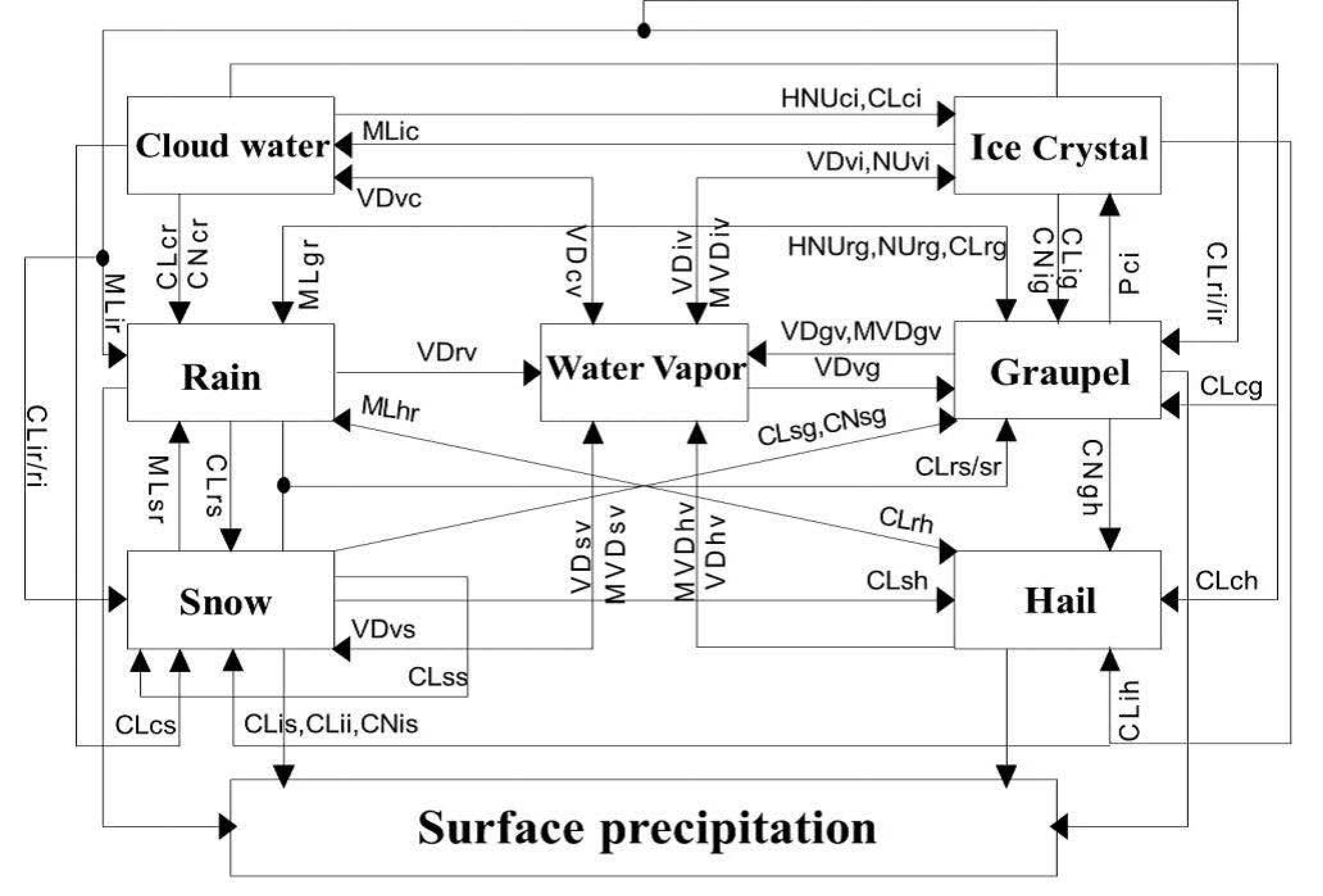
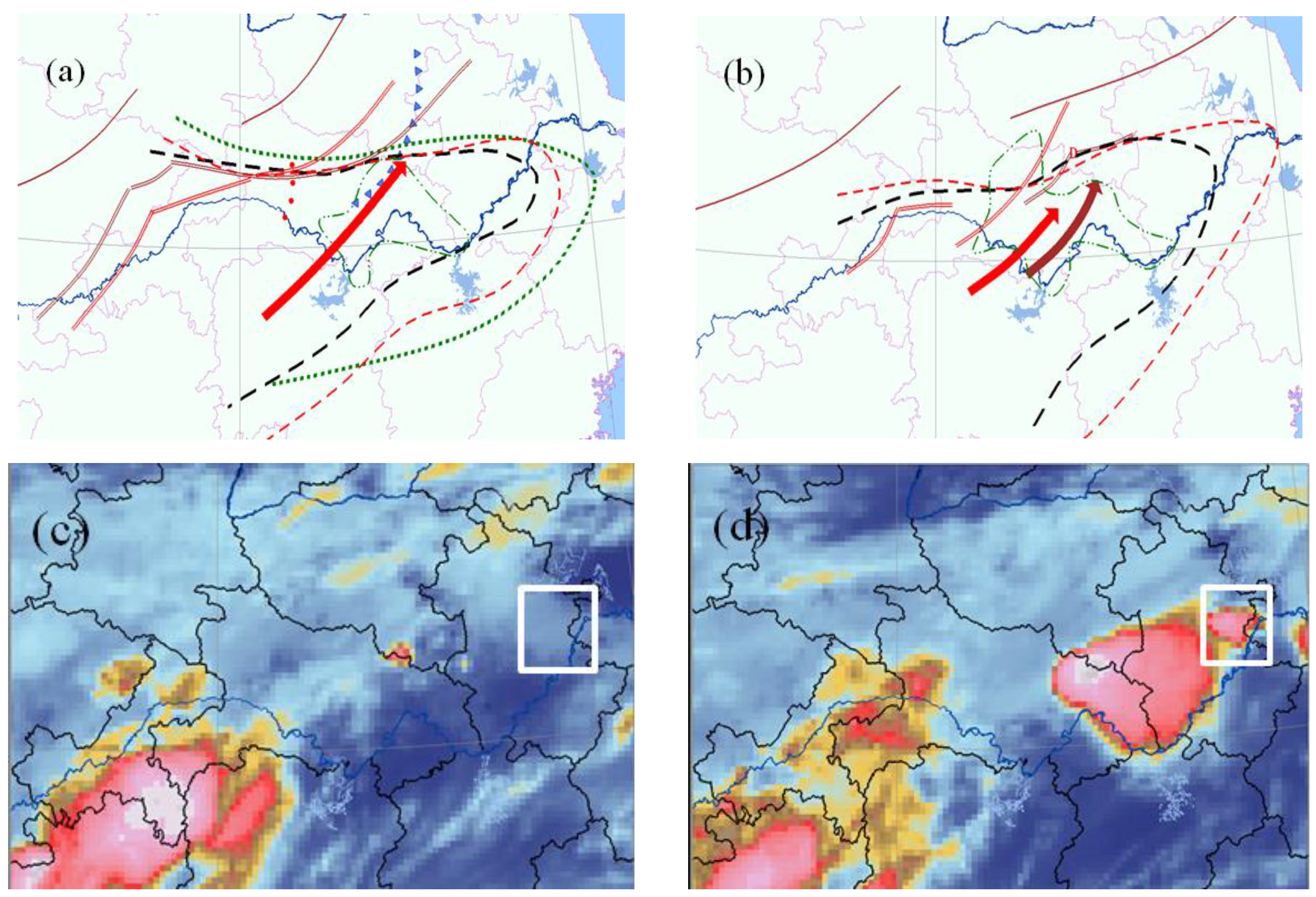

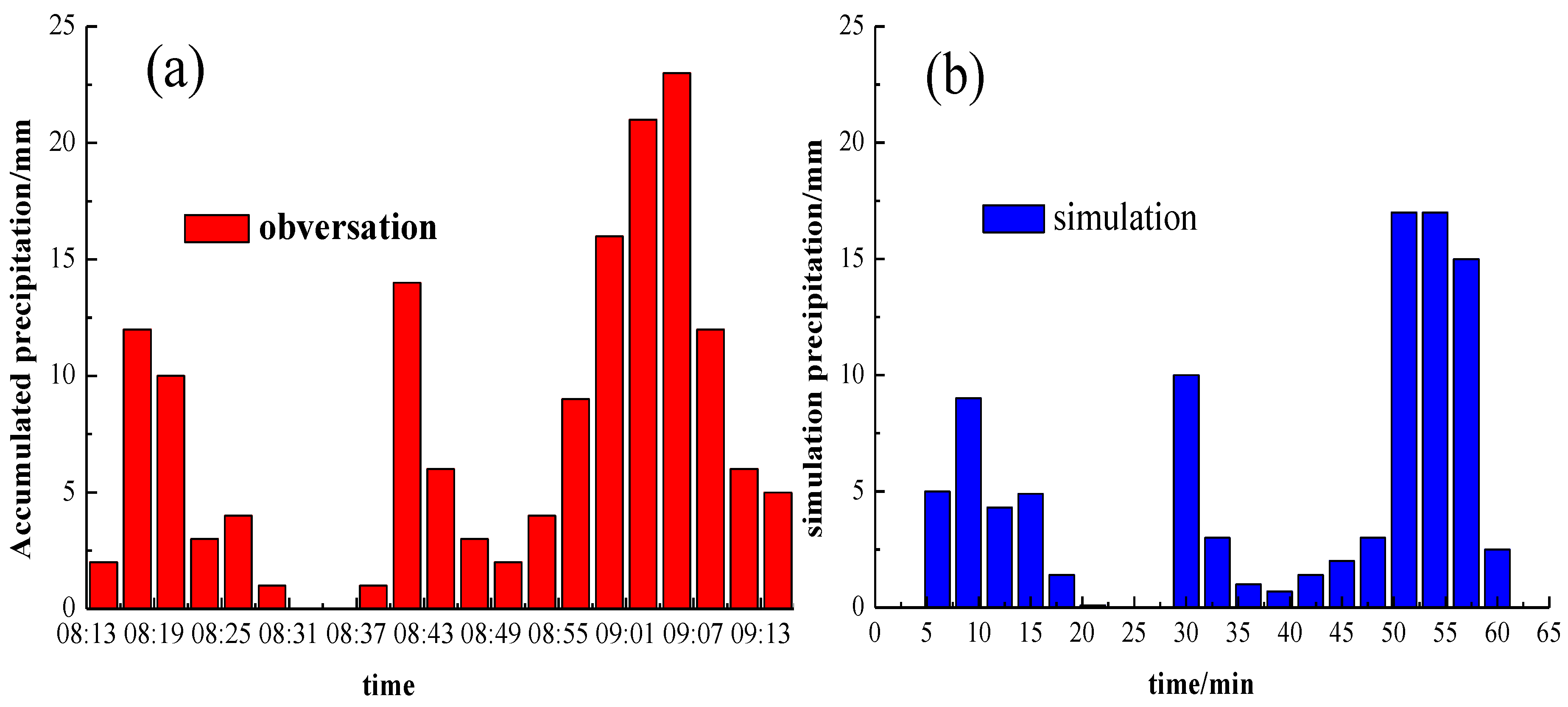
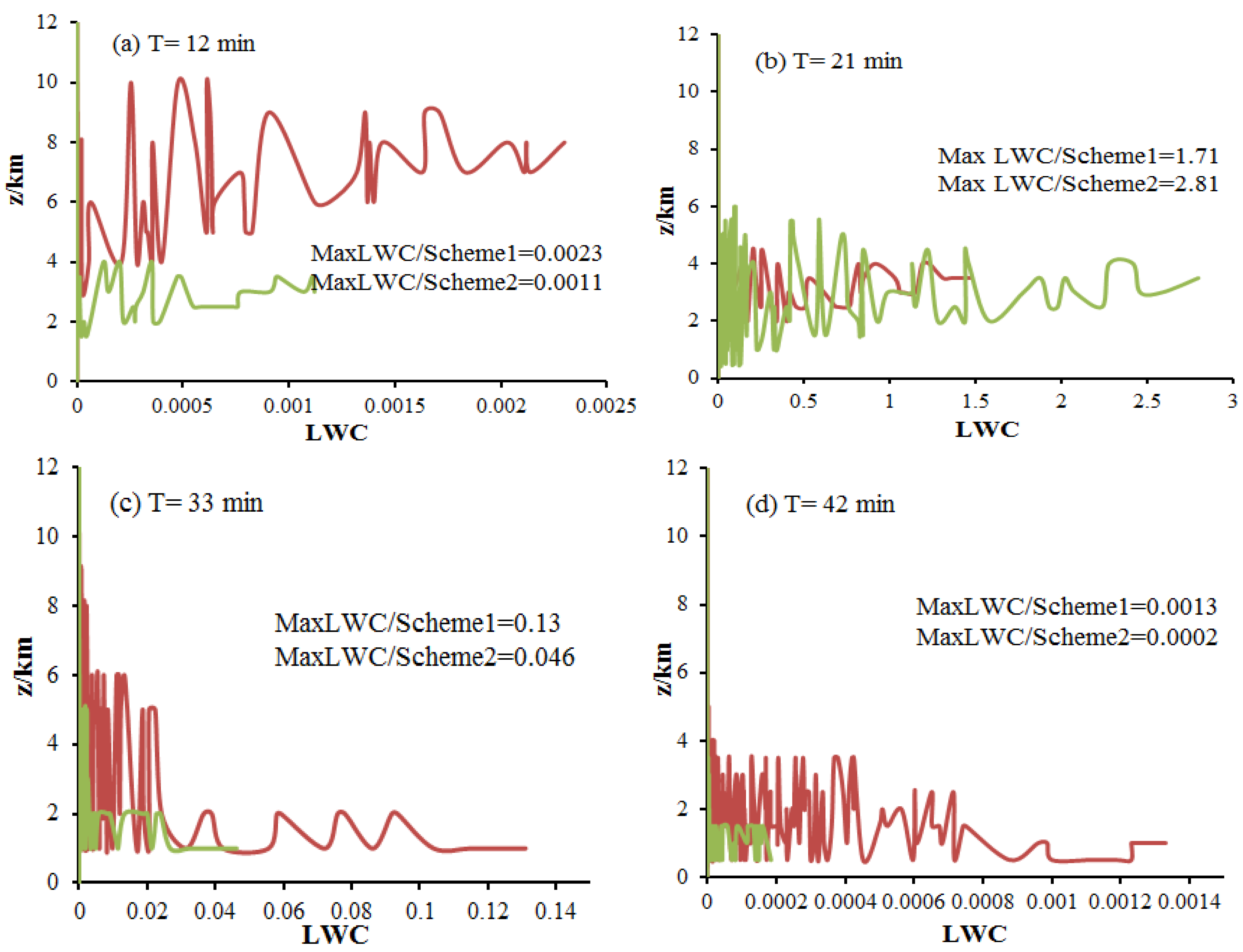


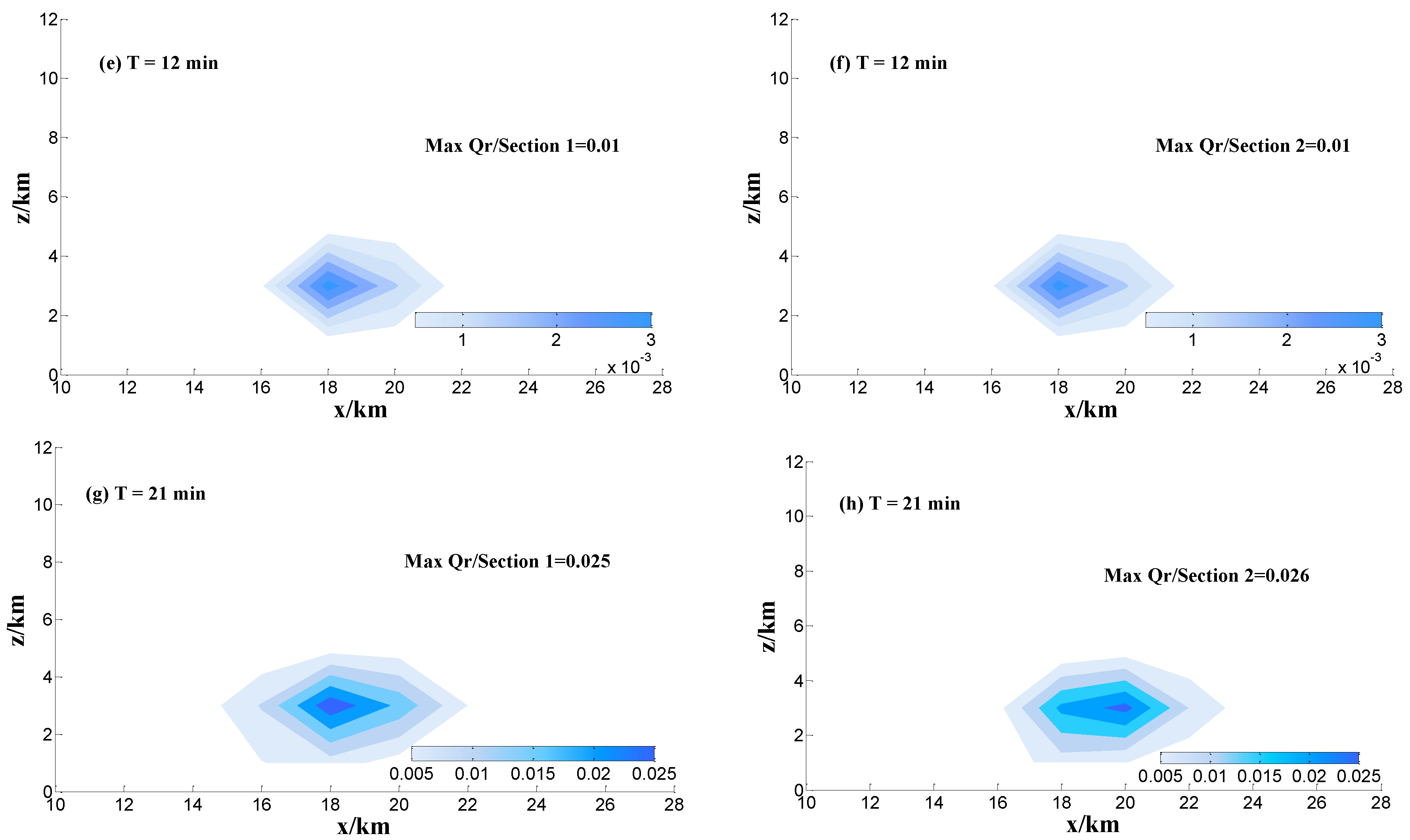
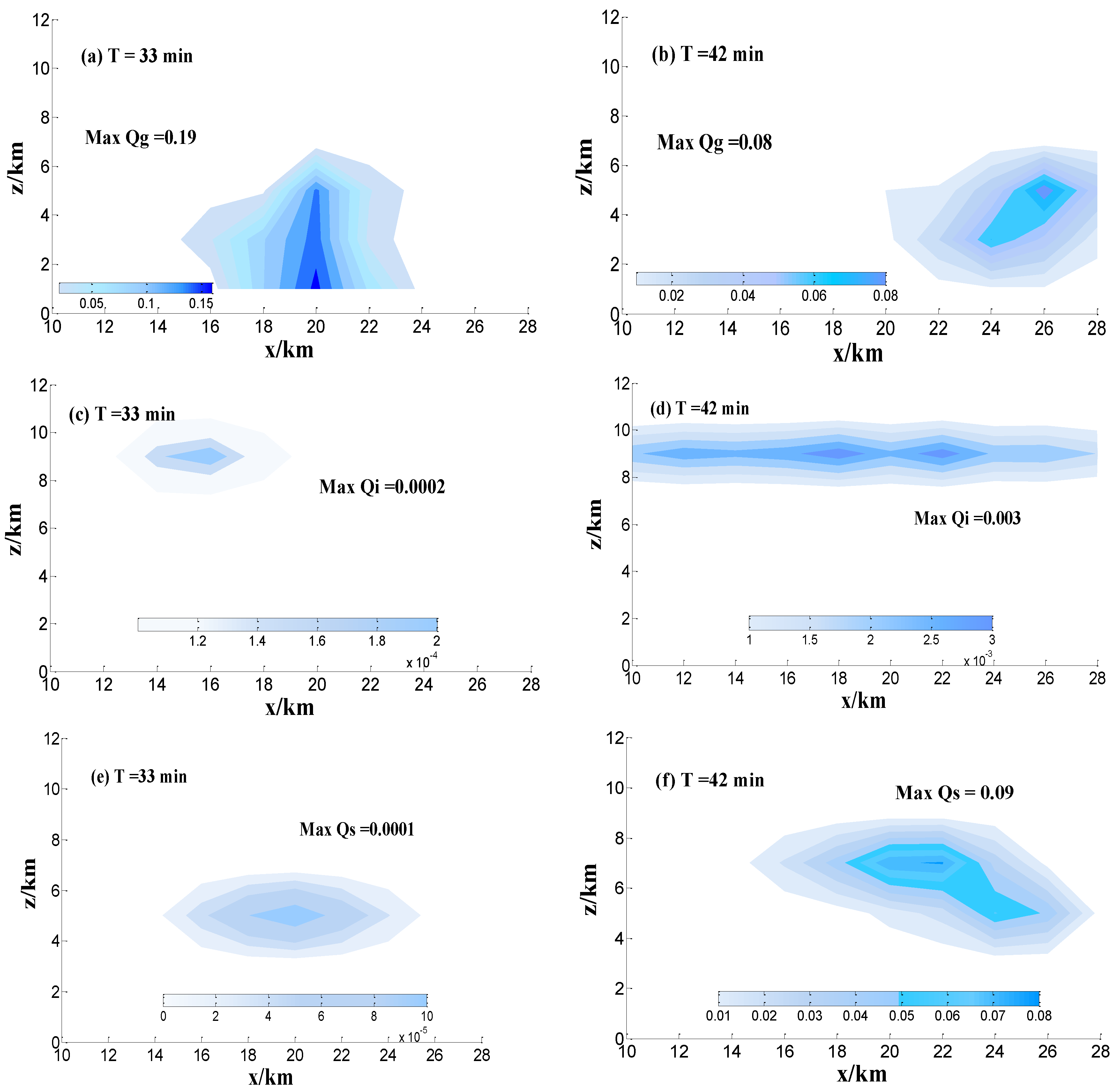
| Parameterization | Initial Echo Height/km | Height of 45 dBz Radar Echo’s/km | Maximum of Radar Echo’s/dbz | Width of Cloud/km |
|---|---|---|---|---|
| observation | 5.3 | 7.4 | 60 | 25 |
| simulation | 5.2 | 7.0 | 65 | 20 |
| Parameter | Section 1 | Section 2 |
|---|---|---|
| Qc Maximum (g·m−3) | 2.84 | 2.84 |
| Time of Qc Maximum (min) | 9 | 9 |
| Qr Maximum (g·m−3) | 6.5 | 6.66 |
| Time of Qr Maximum (min) | 18 | 18 |
| Qg Maximum (g·m−3) | - | 0.5 |
| Time of Qg Maximum (min) | - | 21 |
| Qi Maximum (g·m−3) | - | 0.3 |
| Time of Qi Maximum (min) | - | 42 |
| Qs Maximum (g·m−3) | - | 0.5 |
| Time of Qs Maximum (min) | - | 54 |
| 0–15 min | 15–30 min | 30–45 min | 45–60 min | |
|---|---|---|---|---|
| CNcr | 0 | 0.02 | 3560 | 31,201.5 |
| CLcr | 910.7 | 1059.89 | 6.46 | 0 |
| MLgr | 0 | 0.3 | 0.1 | 0 |
| MLir | 0 | 0.1 | 0.1 | 0 |
| MLsr | 0 | 0.1 | 0.3 | 0 |
| 0–15 min | 15–30 min | 30–45 min | 45–60 min | |
|---|---|---|---|---|
| NUrg | 1380.1 | 5957.4 | 6140 | 192.7 |
| CNsg | 0 | 693.9 | 293.3 | 0 |
| CLcg | 0 | 1416.7 | 1217 | 0 |
| CLrg | 1.1 | 55.6 | 307.9 | 412.1 |
| CLig | 0 | 8.2 | 26.1 | 15.3 |
| CNig | 0 | 0.2 | 12.5 | 6.8 |
© 2016 by the authors; licensee MDPI, Basel, Switzerland. This article is an open access article distributed under the terms and conditions of the Creative Commons Attribution (CC-BY) license (http://creativecommons.org/licenses/by/4.0/).
Share and Cite
Sun, J.; Shi, Z.; Chai, J.; Xu, G.; Niu, B. Effects of Mixed Phase Microphysical Process on Precipitation in a Simulated Convective Cloud. Atmosphere 2016, 7, 97. https://doi.org/10.3390/atmos7080097
Sun J, Shi Z, Chai J, Xu G, Niu B. Effects of Mixed Phase Microphysical Process on Precipitation in a Simulated Convective Cloud. Atmosphere. 2016; 7(8):97. https://doi.org/10.3390/atmos7080097
Chicago/Turabian StyleSun, Jing, Zheng Shi, Jian Chai, Guirong Xu, and Ben Niu. 2016. "Effects of Mixed Phase Microphysical Process on Precipitation in a Simulated Convective Cloud" Atmosphere 7, no. 8: 97. https://doi.org/10.3390/atmos7080097





